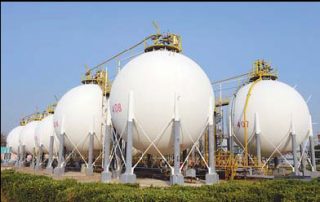Eng. AlSayed Amer
The ongoing process of producing hydrocarbons from a well is a dynamic process and this is often evidenced in terms of changes in the rock or fluid production characteristics.
Problems are frequently encountered as a results of many reasons will be discussed.
Associated Production Problems
There are three basic problems which reduce gas flow from natural gas wells that have a sufficient reservoir pressure, porosity and permeability in a surrounding sand formation:
1- Restriction of gas flow through casing perforations (sand covers perforations).
2- Liquid loading of production tubing with water or condensate.
3- Back pressure on wellhead.
- Sand production and perforation blockage
When sand moves and covering the casing perforation (sometimes a sand bridge accumulated and above the perforation). A greater reduction of gas production will be observed.
Reasons for this problem
The sand production or perforation blockage is a problem resulted from many reasons:
- Wellhead chock opening is large.
- Well was shut in for a long time which led to settling of suspended sand to the bottom.
- The mechanical collapse or breakdown of the formation may give rise to the production of individual grains or “clumps” of formation sand with the produced fluids.
- Failure of gravel pack in case of gravel pack completion.
- In formations containing siliceous or clay fines, these may be produced with the Hydrocarbons creating plugging in the reservoir and wellbore.Problem investigation and confirmationTo confirm if sand is indeed covering the perforations or not, a weighted wireline is lowered through the tubing, when the wireline losses tension then the wireline surface operator realized that the weight has “tagged bottom”.
This tagged depth is compared to the well completion tally record to insure if any or all perforations was covered by sand.
If 20 % to 30% of perforation was covered, then it is a good idea to wash the well out with a coil tubing unit.Effects of Sand Production Sand Erosion. Caused by the presence of solids combined with high velocity. Occurs in tubing, pipework, in zones of diameter restriction & turbulence such as chokes, elbows.Loss of production. Installing sand control equipment will decrease the production rate due to the pressure drop across the unit.Sand disposal. Sand production rate of 0.1% of the produced fluid generates 5.62cu.ft (0.159m3) of solids per 1000bbls of production.Overcoming the problem
At bottom, gravel packing systems are the most common methods used.
At surface, in well testing, three Schlumberger purpose-built types of sand removal units are used:– Dual-pot Sand Filter.
– Sand Separator.
– Cyclonic Desander.
Gas well Liquid loading
“Liquid loading of a gas well is the inability of produced gas to remove the produced liquids from the wellbore” when the gas velocity is not sufficient to entrain the liquid out of tubing (entrainment velocity). The produced liquid will accumulate in the well, therefore creating a hydrostatic pressure in the well against formation pressure and reducing production until the well ceases production.
Problem reasons
- There may be an aquifer below the gas zone which may either lead to water coning
or water encroachment. - The source of liquids may be another zone or zones, especially if the completion type of the well is open hole.
- The water produced along with gas may be free water present in the formation.
- Depending on the reservoir, bottom hole and tubing head pressures water and/or Hydrocarbon vapor may enter the well and condense while travelling up the production tubing, coming out of liquid.
Source of liquids
Water coning: If gas rate is high enough, water may be “sucked” to perforated zone from a water zone below.
Aquifer Water: Pressure support from a water zone may lead to the water zone “traveling” to perforations.
Water produced from another zone.
Free formation water: Water and gas come from the same zone.
Water of Condensation: Condensation can occur higher in the well (p/T dependent), which can cause water to fall back and accumulate at perforations. Temperature decreases and/or pressure increase -> water vapor will condense out of gas. Condensed water can be identified by low or no salt content
Factors that influence liquid loading
- Tubing size.
- Surface pressure.
- Amount of liquids being produced with the gas.
Recognition of Liquid Loading
Unnoticed liquid loading can result in reservoir damage.
- Memory gages can detect the height of liquid columns.
- Echometer device can detect liquid level in casing.
Overcoming the problem
- Conventional plunger lift systems use well shut-in pressure buildups to efficiently lift columns of fluid out of well without venting.
- Shutting in the well to allow bottomhole pressure to increase, then venting the well to the atmosphere (well blow down).
- Swabbing the well to remove accumulated fluids.
- Installing velocity tubing.
- Installing an artificial lift system.
- Use Foaming Agents.

